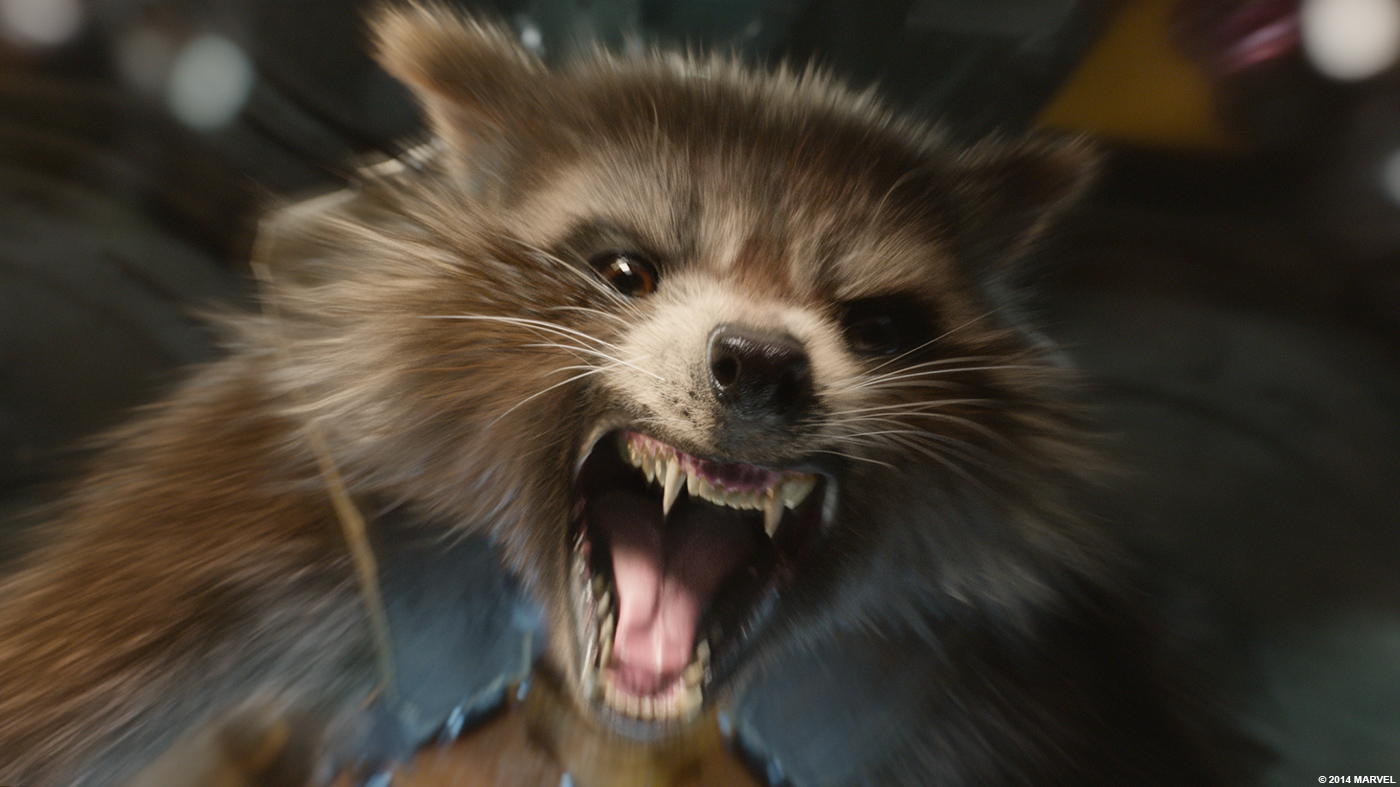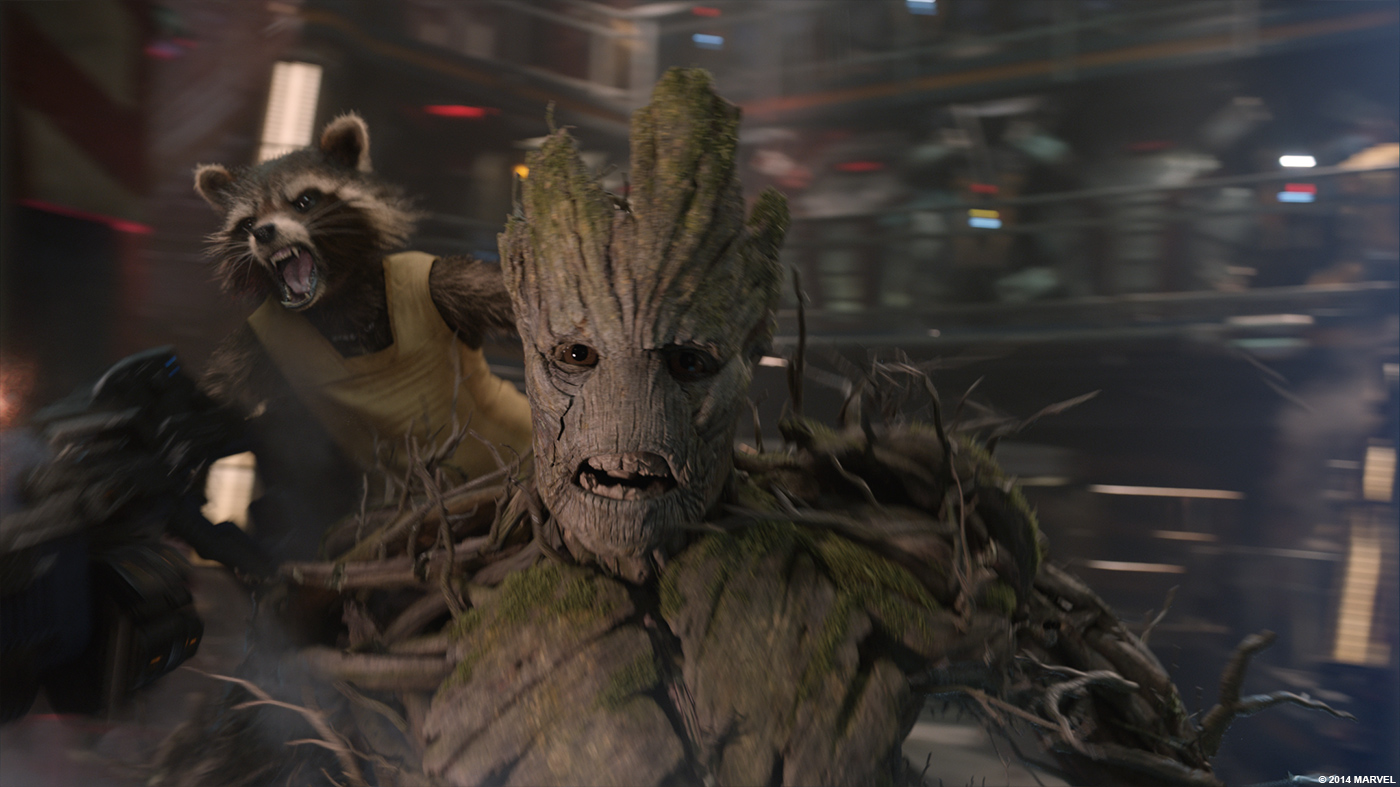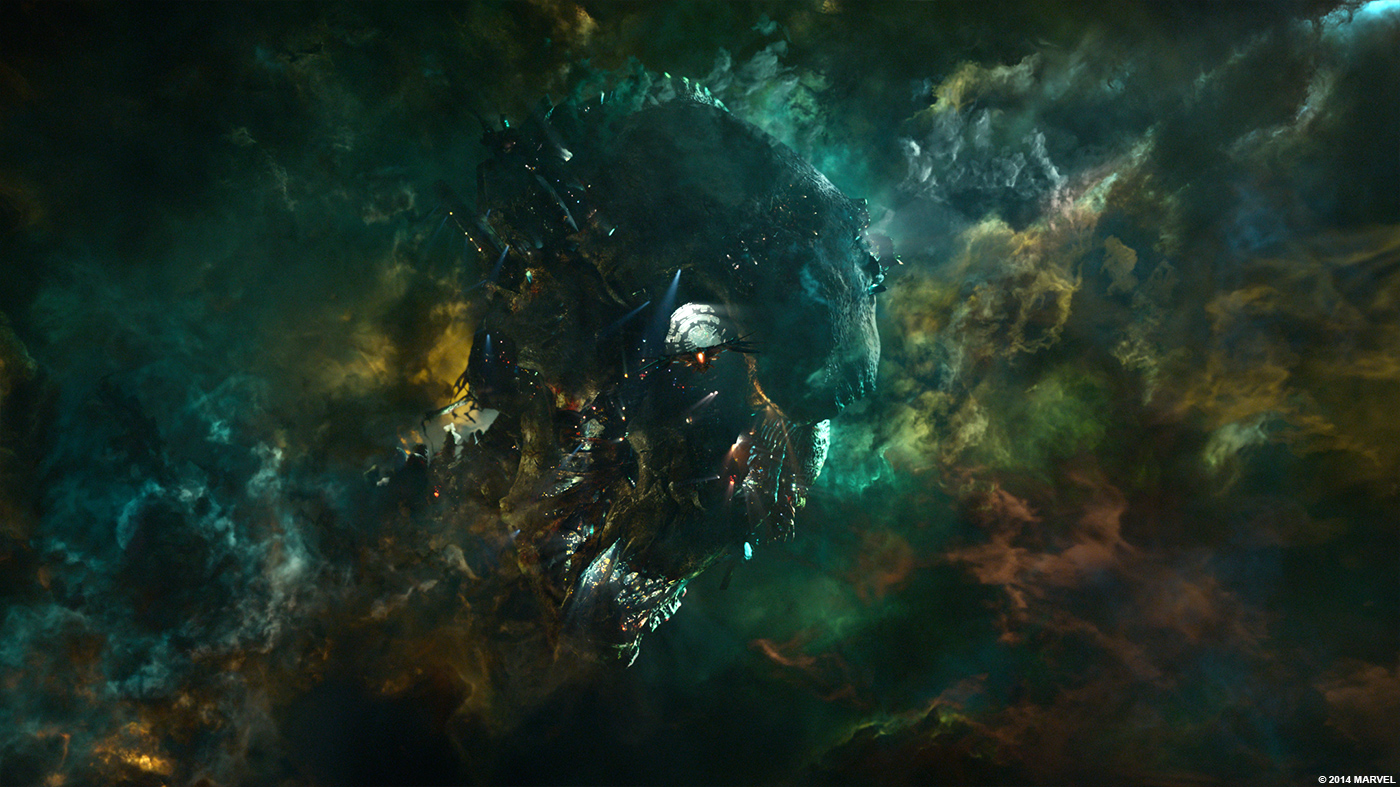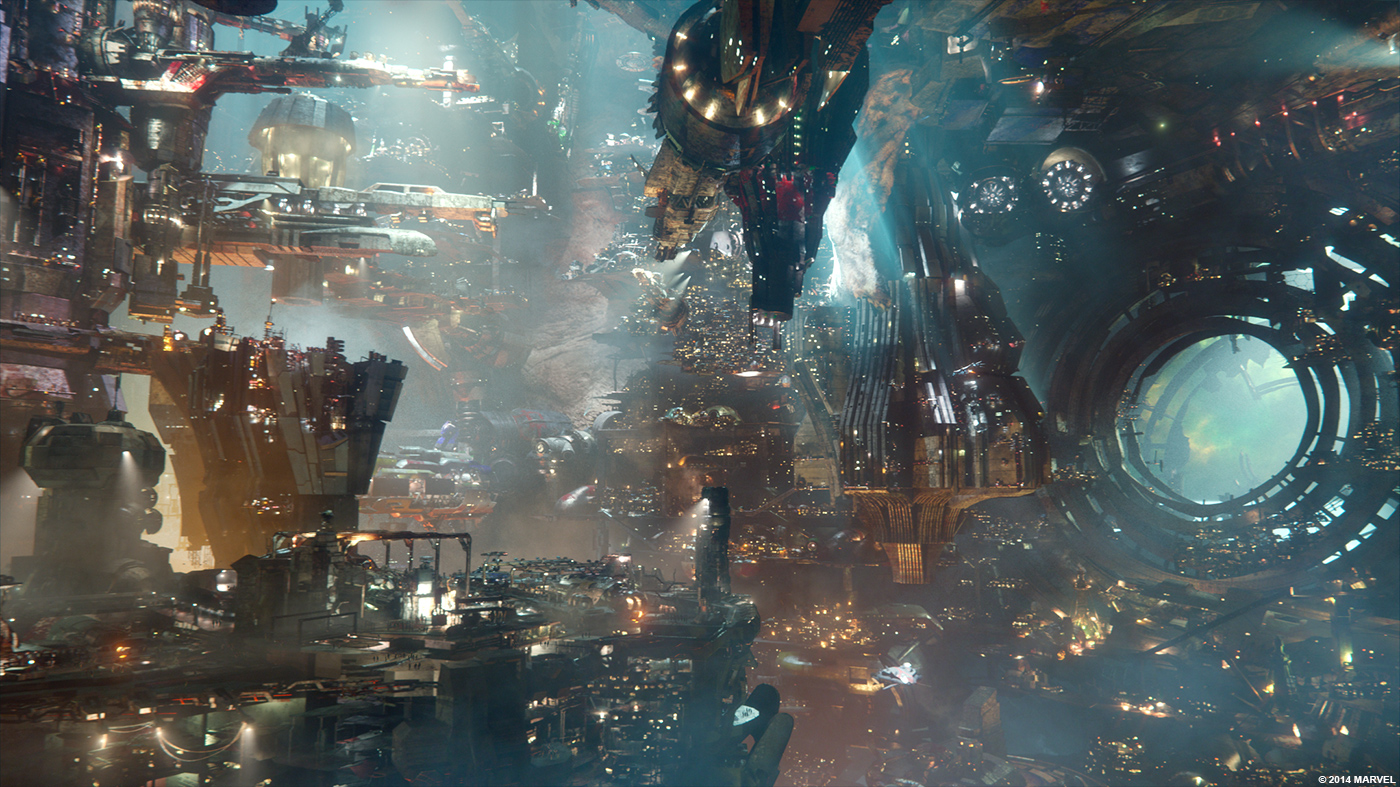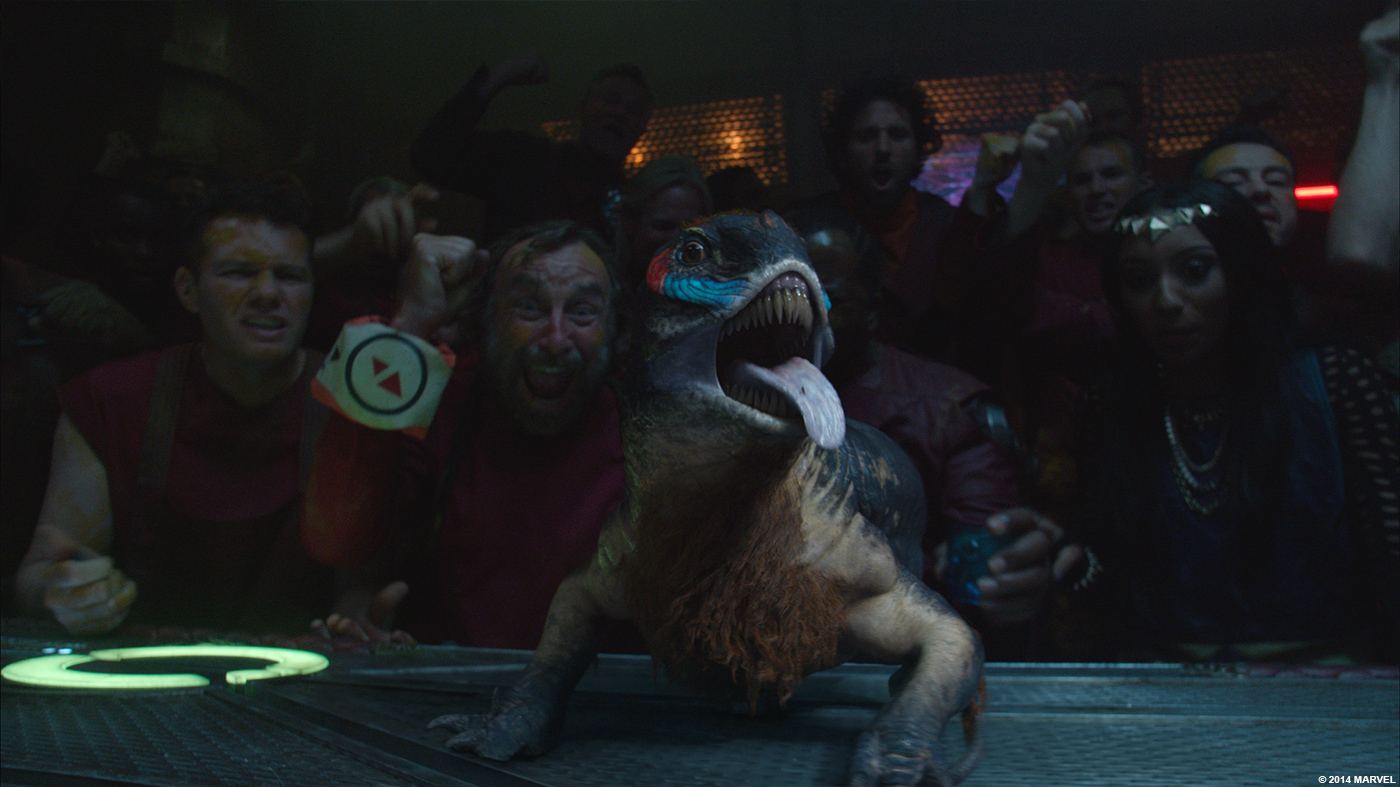Kyle McCulloch is in visual effects for over 15 years. He worked in many studios such as Curious Pictures, The Orphanage or ILM. He joined Framestore in 2009 and worked on films such as HARRY POTTER AND THE Deathly HALLOWS: PART 1 or GRAVITY.
Mark Wilson began his career in the VFX in 1999 at Passion Pictures. Then he joined Framestore in 2006 and worked on films like AVATAR, LINCOLN or GRAVITY.
What is your background?
Kyle McCulloch – VFX Supervisor // I studied film in college, and started my career working at a studio that did traditional and stop motion animation. From there, I moved into visual effects and worked in both commercials and film.
How did you got involved on this show?
Kyle McCulloch – VFX Supervisor // I came onboard GUARDIANS OF THE GALAXY right before the start of principle photography. I spent four months on set, helping to supervise the shoot, while Jonathan (Fawkner, Framestore’s other VFX Supervisor) worked back at Framestore to build Rocket raccoon.
How was the collaboration with director James Gunn?
Kyle McCulloch – VFX Supervisor // Working with James was one of the best director experiences I’ve had in visual effects. He was passionate and engaged in the entire process, and being one of the writers of the film meant he had a very personal connection to Rocket. He was incredibly generous with his time, meeting with us two to three times a week to discuss the work we were doing. I think a big part of the success of Rocket is thanks to his commitment to directing our animators, and really taking part in the VFX process.
What was his approach about the visual effects?
Kyle McCulloch – VFX Supervisor // James is a story teller, and he definitely saw VFX as part of his tool kit to tell his story. We were bringing his main character to life, and so he was in quite a few of our reviews and sessions, constantly communicating with our teams about who Rocket was, and what performance he wanted.
How did you work with Production VFX Supervisor Stéphane Ceretti?
Kyle McCulloch – VFX Supervisor // Stef was fun and easygoing throughout the process of creating GotG. Regardless of how stressful the production became, we always enjoyed our calls and meetings with Stef – he was great at working with the Marvel team, and collaborating to solve all of the tricky problems we had on the show.
What are the sequences done by Framestore?
Kyle McCulloch – VFX Supervisor // We did the Kyln and Knowhere sequences, which included 646 shots of characters, environments and FX.
Can you describe one of your days on-set and then during the post?
Kyle McCulloch – VFX Supervisor // A typical day on set for me usually involved shooting setups with Rocket and Groot in them. The crew were very methodical in how we approached these shots. We’d always start a setup with our stand-ins – we had a little person stand-in for Rocket, and a gymnast wearing an extended helmet for Groot. Once the action was blocked, we’d take our stand-ins out, and mark out all the various eyelines for the rest of the actors. From there, we’d run as many takes as required to get the shot James was looking for. Often, Sean Gunn, the actor who was playing Rocket on set, would stand in and perform a shot with the actors. For more dramatic moments, this helped us get the best take for the rest of the actors, but meant we’d have more clean-up in post. Lastly, we’d put in our lighting reference for Groot and Rocket – we had a correct scale stuffed raccoon in costume, and a maquette face for Groot, which we’d film to make sure we knew exactly what they were meant to look like in the set lighting.
The post production process involved a huge team of artists – we had almost 300 people on our crew. We were fortunate that we had so many talented and experienced leads to head up the individual departments involved in shot production. My average day was spent in various review sessions, looking at the work, and moving the whole project forward. We had daily meetings with our clients to show them the work, and get feedback quickly – with such a short post process and with so many complex shots to do, it was important that we stayed closely connected to Marvel and their creative team.
How did you approach the design and the creation of Rocket?
Mark Wilson – CG Supervisor // We had initial concepts from Marvel which were a great guide towards some of the characteristics of Rocket and the first step to taking that into a 3D asset was to work out what Rocket’s anatomy would be like. The obvious place to start was with a skeleton and proportions from a real raccoon. We built that from reference and posed it on its hind legs and looked at how that could work. The skull was particularly useful in laying out the facial geography and proportions. For the body it was immediately obvious that real raccoons have proportions that don’t suite an anthropomorphic stance and this is where we made the larger changes. We got to the main proportions of Rocket quite quickly but then went through many weeks of small adjustments to get to the final character.
Can you explain in detail about his rigging and animation?
Mark Wilson – CG Supervisor // Rocket was for the most part a standard biped rig. Basing the model on real anatomy meant that when we came to building the rig we could be accurate about joint positions, pivots and muscle placements. The majority of the rigging time for Rocket was spent on the face due to him having so much dialogue. The face rig was blend shape based and due to the face being covered in fur extra attention had to be put into the wrinkle definition to make sure it read ok. We used FaceShift facial capture during the development stage to test out the rigs performance range. The bounty hunter suite Rocket wears in half the film was quite complex as it had several straps connecting to pads etc. We re-purposed some of the suit rigging techniques we used on IRON MAN 3 to help with this.
How did you handle the fur challenge?
Mark Wilson – CG Supervisor // Raccoon fur is quite complex from a shading perspective. We had a real raccoon skin in the office which we used as reference. Across the coat the fur changes colour but it also changes colour down the length of each hair. In different places on the coat there would be up to three colour changes along a given hair. We developed a shader to handle this fur mapping so it could be driven by textures to decide how many colour changes happened along the hair and what colours they would be. The hair also has two lengths, which we referred to as the down hair and the guard hair. The down hair was single colour, short and soft looking, and the guard hair has much longer, less dense, and had all the multi colour shading. We used two independent grooms for these so we could easily avoid running unnecessary dynamics on the down hair.
The fur dynamics was solved with our in house tool fDynamo. SDF data was computed for the collision geometry and then the dynamics simulation was run. After simulation a finalling pass was required to clean up any problematic hairs from the sim as well as improving the look on certain facial expressions, an example being Rockets cheek fur. The hairs were very long in that region and when he smiled or squeezed his cheeks up in a squint the hair tips would move around a lot. The solution to this was to wrap deform the tips to a head mesh which didn’t have the facial animation on it, the result being a dampened tip movement which felt more natural and preserved Rockets look.
Can you tell us more about Groot’s animation?
Mark Wilson – CG Supervisor // Groot’s character was developed by MPC and then they supplied us the model, textures and skeletal information to match their asset. Initial ingestion of the textures and model went well and although we were using different renderers and shaders the line up was incredibly close. The much bigger challenge was the rig. MPC and Framestore both use a lot of custom in-house tools for rigging so although some data and information could be shared we largely had to build the rig from scratch. Groot’s body was made up of hundreds of vines that all moved independently as he walked and made this a time-consuming process to match. The final rig had several layers starting with a basic skeleton which then had lots of curves deforming the geometry using custom in house deformers. There were also layers for growing new vines from his arms and legs, growing twigs from existing vines and a system for growing the vine shield he uses to defend himself. The facial rig also had a layer of complexity in the way the bark split apart as he pulled different expressions around his mouth and eye brows. As with the body, due to MPC achieving this with their internal tools we couldn’t easily share data and had to rebuild using our own tool set.
How did you create the Kyln prison exterior and interior?
Mark Wilson – CG Supervisor // The Kyln was built from modular parts. We built the main struts, walkways, doors etc and then assembled them together using our in-house layout tools. Due to the number of light sources and it being an interior set it lent itself well to being rendered using our in house bi-directional path tracer which works inside of Arnold. This made the renders a lot less noisy and thus much faster due to the lack of samples required. The exterior of the Kyln was a combination of renders and matte painting.
When Rocket turns off the gravity in the Kyln we switch out a lot of live action elements to full cg ones. The majority of the set, the watch tower, all of the guards and props etc were all CG and right in front of the camera. Once Rocket starts to connect the prison hoverbots to the watchtower in order to fly out of the Kyln, these shots are full CG. The tunnel part involved lots of CG FX passes, namely for the hoverbot thrusters, hoverbot destruction, tower destruction, tunnel destruction, sparks, dust and fire. Some elements of the watch tower where shot on a gimbal to have the actors inside the windows but even some of those were replaced with digi-doubles.
Can you explain in detail about the creation of Knowhere?
Kyle McCulloch – VFX Supervisor // Where to start! Knowhere was the biggest and most complex environment we’ve ever tackled at Framestore. Constructing such a huge place presented a myriad of challenges in all the traditional departments – modelling, texturing, and lighting. We couldn’t use any of the ‘cheats’ that you often employ with an environment like this – James wanted to be able to fly his ships around and next to any part of this world that was required, so we needed to build an asset that would be flexible enough, and hold up to that level of scrutiny.
To construct the actual model, we worked closely with our internal art department to design a kit of parts that would provide the building blocks for the world. We ended up with 250 individual models that were then used by our environment team to construct all of Knowhere’s interior. We started with the biggest, hero shots – building out the structures that were needed for the particular action. From there, we’d continue building and detailing while looking through other shot cameras, making sure that the single asset would work in every shot. We developed an in-house system using instancing to manage the huge number of models that were required in each shot. In all, we used over 84,000 instances of models, and our biggest shot had over 1.2 billion polys visible to camera.
In parallel we were working on a system to texture the place. Using a traditional technique of texturing the individual assets wouldn’t be efficient, and wouldn’t provide us the flexibility we needed, so we went with a 6 planar projection method. We designed 6 different zones within Knowhere, each with it’s own type of colour, mood and lighting, and then used attributes on the layout to control which areas of the build received which zone textures.
Lighting Knowhere was also a big challenge – it was an enclosed space, so we weren’t able to use traditional environment light techniques. Instead, we had teams of lighters tackling different aspects of each shot. One group were placing ‘local lights’ – individual lights within the set that were street lamps, window lights, and other architectural detailing lights. Another team were handling the medium and large scale lights – the overall ‘set’ lights that lit each shot. We’d also include a few massive lights within the setups, to give overall temperature and tone.
Mark Wilson – CG Supervisor // Lighting was a two step process. Layout would dress in local lighting for all of the buildings for windows and street lights etc. A QC render would be done of local lighting for approval and then that would get passed onto the lighting department who were then responsible for the overall shot lighting, and adding the animated elements and FX. Most of the shots inside Knowhere had thousands of light sources and again we used our bi-directional path tracing algorithm inside Arnold to render everything. One of the additional benefits to our bi-directional renders was not only speed but light categorization, so comp could balance light contribution post render based on director feedback.
To texture Knowhere we used a custom tri-planar shading technique based on variables on the geometry. Depending how the geometry had been tagged in layout it would pick up different textures ie more industrial or more residential etc. This meant that we didn’t go through and manually paint textures for any of the models, we just created a texture pool for the different types of looks and then based on layout tagging and shader parameters we were able to make huge variation and imply greater complexity. The tri-planar method of projection also meant we didn’t need to UV the models either.
Can you tell us more about the spaceship chase sequence?
Kyle McCulloch – VFX Supervisor // The pod chase in Knowhere was heavily prevised – James had spent a year before we shot working out a lot of the film, figuring out exactly the action and beats that he wanted. We started at the previs, and worked from there – really developing the type of motion and characteristics each ship had. In many cases we needed to change or propose different or more finessed action to really make the sequence as exciting as possible.
We filmed the actors in a full-size space pod on a gimble for their hero shots. Having developed an in-house pipeline on Gravity for putting the actor’s faces in their helmets, we used the same process to put the actors and their cockpits in the CG ships. This allowed us to easily animate on top of what had already been shot, giving us the flexibility to give James the shots he wanted.
The spaceship chase have many FX and explosions. Can you tell us more about these elements?
Kyle McCulloch – VFX Supervisor // The biggest FX challenge within the pod chase were the big, slow motion explosions. In order to achieve these simulations we had to work closely with our RnD team, to update our solvers to handle time sampling at the high rate that was needed. There were also quite a few of other FX pieces to the sequence – we had blasters, thrusters, and impact explosions. We developed a new set of pipeline tools to help us replicate similar effects of a large number of shots – they enabled artists to easily chain together multiple actions and processes, so that once a workflow had been set, any artist could apply it to their shot.
Mark Wilson – CG Supervisor // There are a lot of FX throughout the Knowhere space pod chase involving explosions, destruction, blasters, and thrusters. For the explosions we built a library of generic explosions using our in-house fluid simulation software. These assets where then dressed into shots for blaster hits on the set etc. The blasters were particle sims that were driven by animation setting fire and aim controls in the rig and the thrusters were fluid simulations also triggered by animation controls. Simulation rigs were setup and published as assets. For any given shot the FX data could be generated by simply importing the anim cache, connecting the simulation rig and then simulate. This process was run as command line and allowed us to accommodate anim changes after FX were approved. The big FX shots like when Rocket smashes his spacepod through a necrocraft, were hero simulated for the destruction and fire using all in house software and rendered in Arnold.
How did you created the rich environment of the Collector’s Lab?
Kyle McCulloch – VFX Supervisor // We started the Collector’s Lab from a single concept painting provided by the clients. We knew the Collector had thousands of cases, filled with a huge variety of objects. We used our same instance based environment pipeline that we developed for Knowhere to lay out a huge number of cases and their contents. We had a good time picking out all the different features and objects to fill the cases.
Can you tell us more about the Orloni table?
Kyle McCulloch – VFX Supervisor // The Orloni table was something James and the production spent a lot of time thinking about – everything from the construction of the table, to the actual rules of the ‘game’! We tried to find interesting real creatures that we could use as inspiration for the animal movement.
Mark Wilson – CG Supervisor // The Orloni and F’Saki character design and animation development was really fun as they are such whacky characters. The Orloni looks viscous and gross but it’s the dopey looking F’Saki that is actually the predator. For the Orloni we referenced the Jerboa for movement and fish, frogs and shrimps for texture. The F’Saki was more puppy-like in movement with texture reference from Crocodiles, lizards, and tortoises. Both characters have rather odd anatomy and the Orloni is semi transparent so we had to also model all of his internal organs, skeleton, and vascular system. This made him the heaviest rig we had in terms of memory due to the amount of geometry that was being deformed.
What was the biggest challenge on this project and how did you achieve it?
Kyle McCulloch – VFX Supervisor // Our biggest challenge was making sure we really got the character of Rocket right. James Gunn has a deep love for the material and the character – he wrote him! So, from start to finish, our biggest focus was on giving life to exactly the crazy, homicidal and demented character that James was looking for.
How did you split the work amongst London and Montreal?
Kyle McCulloch – VFX Supervisor // We didn’t. All the work for GUARDIANS was done in London.
Was there a shot or a sequence that prevented you from sleep?
Kyle McCulloch – VFX Supervisor // Knowhere – tackling an environment with so many technical challenges and problems we’d never tackled before definitely caused me to sweat a bit!
What do you keep from this experience?
Kyle McCulloch – VFX Supervisor // I am so proud of the characters and world we created, and having the opportunity to work with such a talented director. We assembled a world class team of artists, and the work shows it!
How long have you worked on this film?
Kyle McCulloch – VFX Supervisor // A little more than a year for me
How many shots have you done?
646 finaled shots.
What was the size of your team?
379 total crew.
What are the four movies that gave you the passion for cinema?
Kyle McCulloch – VFX Supervisor // I’ve had a love of film my entire life, which started with the Henson films of the 80s. LABYRINTH and DARK CRYSTAL, along with THE NEVERENDING STORY and WILLOW were completely mesmerizing to me. I loved seeing utterly fantastic realms brought to life.
What is your next project?
Kyle McCulloch – VFX Supervisor // PAN directed by Joe Wright.
A big thanks for your time.
// WANT TO KNOW MORE?
– Framestore: Dedicated page about GUARDIANS OF THE GALAXY on Framestore website.
© Vincent Frei – The Art of VFX – 2014


